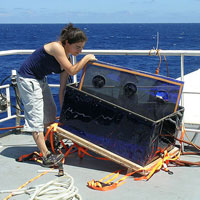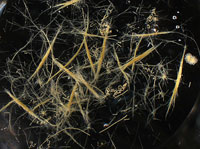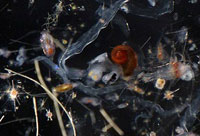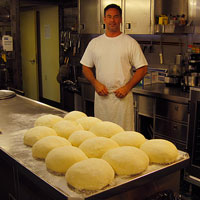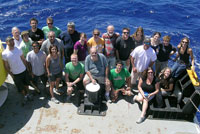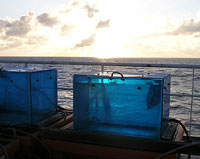- C-MORE Home
- What is Microbial Oceanography?
- What is C-MORE?
- Research
- • Research Cruises
- » BioLINCS
- Home
- Cruise Participants
- Instruments Used
on the Cruise - Nitrogen Cycling
- Marine Microbes
- Cruise Blog
- Data Archive
- Education & Outreach
- People
- Publications
- Image Library
- Contact Us
| |||||||||||||||||||||||||||||||||||
BioLINCS Cruise Blog
Tuesday, September 20, 2011
|
Jessica Bryant disassembles her incubation chamber on the top deck of the Kilo Moana. |
|
Craig Taylor and Ben Rubin wrestle one of Craig’s incubation productivity systems (IPS) into its crate for shipping back to Woods Hole. |
|
This drop of water holds several different species of Trichodesmium, the most abundant type of marine cyanobacteria near the sea surface during this cruise. |
|
This microphotograph shows some of the tiny animals that inhabit the near-surface ocean along with Trichodesmium. These include long, translucent arrow worms, shrimp-like copepods, a marine snail, and many other creatures. |
|
They say that an army marches on its stomach. I would modify that to say that a ship sails on its chef. Shawn Lindenmuth, the Kilo Moana’s chief steward, prepared an amazing variety of delicious food, including these mounds of freshly made pizza dough, rising in his galley. (Photo by Ger van den Engh) |
|
The science crew for the BioLINCS cruise included researchers of all ages and levels of experience. Everyone worked together to gather an amazing amount of samples and data. By the time this image was taken, we were heading back toward O‘ahu, most of the work had been completed, and people could relax a little bit. |
|
I couldn’t resist including one last sunset photograph, this one showing a few remaining bags of seawater (and microbes!) in the incubators on the top deck of the Kilo Moana. This cruise has given me a new appreciation for the amazing diversity of organisms living in the clear blue waters of the open Pacific. |
It’s about six thirty in the evening here on the Kilo Moana. To starboard, the sun is setting, a small gleam of fire peering between cauliflower heads of cloud. Just off the port bow, we can see land for the first time in 13 days. It’s just a darker gray silhouette beneath lighter gray clouds, but it has a certain refreshing solidity about it. I can make out the rise of the Ko‘olau Range, and over to the right, Ka’ena Point jutting out into the sea.
In Hawaiian legends, Ka‘ena Point is one of the jumping-off places for the souls of the dead. But at the moment, it looks very welcoming, despite the somber lighting. The ocean has been kind. We have traveled far and accomplished much. But now it is time to go home.
There was still plenty of science happening on the Kilo Moana today—three CTD casts made, several incubations completed, a final plankton tow off the transom… But most people were wrapping up, packing up, cleaning up, and thinking about how to get all their gear and samples back to their labs safely, and in a timely fashion.
I took advantage of the relaxed atmosphere to ask John Waterbury if I could look at some of the water from his last plankton tow under one of the really nice microscopes on board the ship. Ken Doggett set up a scope for me, and I was hooked.
At first I was fascinated by all the different types of Trichodesmium, one of the larger cyanobacteria that we’ve been studying, and a major player in nitrogen fixation. Their photosynthetic pigments give them the pale gold color of dried pasta. Like pasta, some come in bundles of long, straight strands. Others form spirals and little star-shaped clusters. John is hoping to identify one or more new species from the samples he collected during this expedition.
Looking at the microscope images from the plankton tow also gave me a greater appreciation for all the other life forms floating around in that luminous blue water we’ve been seeing all around us. There were copepods and arrow worms and microscopic snails and galaxies of other creatures I couldn’t begin to name. They had been smooshed together by the plankton net, but they were all out there, swimming, drifting, eating, and being eaten, along with the Trichodesmium and the myriads of smaller microbes that slipped right through the mesh of the plankton net.
We spent most of the morning collecting water samples at Station ALOHA, an unmarked point in the ocean about sixty miles north of O‘ahu, then headed south after lunch. Soon after heading south, we took a minor detour to do some “scientific tourism,” passing by a deep-ocean research buoy that supports the Woods Hole Oceanographic Time Series (WHOTS) mooring. Aside from the big yellow float for the Environmental Sample Processor (ESP) and a fishing boat that passed by a few days ago, this was the only large floating object most of us had seen since we left land. It’s definitely a big ocean out here…
We’ve spent almost two weeks out here in the middle of nowhere (literally), and completed a really ambitious research program. By my rough estimate, we made between 40 and 50 CTD casts that collected over 12,000 liters of water. We placed six different drifting instruments in the water for up to 10 days each, and got all but one of them back more or less intact. We completed dozens of incubation experiments, both on the ship and underwater, and collected thousands of samples of seawater and particles for later analysis. We performed DNA and RNA analyses on the board the ship to see how what kinds of microbes were present, while a robotic laboratory performed some of these same analyses 25 meters below the surface.
Although the real-time data showed us at what depths some of the microbes were hanging out, and how some of these microbial populations changed over time, we still don’t really know what these data mean. We don’t know why certain types of microbes were at certain places at certain times, or exactly what they were doing there.
Figuring all this out will take months of analyzing samples, and then many more months, or perhaps years, of analyzing data. But at least we know we have some good data to analyze, some potentially useful clues to solve the puzzle of what how nitrogen cycling works in the open ocean.
The success of this ambitious expedition was helped by the fact that we had great weather and the fact that Kilo Moana is a wonderful platform for research. But it was the people on board the ship that really made all this research possible.
The Kilo Moana’s experienced captain and crew made the deck and engine-room work look easy (most of the time). The food on board the ship was fantastic and varied, thanks to the versatile Shawn Lindenmuth, the ship’s chief steward and chef. The marine operations staff from the University of Hawai“i—Trevor Goodman, Blake Watkins, and Kuhio Vellalos—were very patient and a lot of fun to work with, as they labored tirelessly to get all manner of equipment into and out of the water, day and night, whenever it was necessary.
And then there were the researchers on board the ship. From the senior scientists to the interns, they all put in long hours to keep the instruments going out and the data coming in, despite changes in plans and changes in weather. We learned a lot from each other, and about each other. I’m sure many people from this cruise will be communicating and collaborating to produce papers using the data we collected over the past two weeks.
It has been an honor to work with such a dedicated and knowledgeable group of people. In this blog, I have tried to share a few glimpses of our lives at sea with those of you who are reading this on shore, wondering what the heck we’re doing out there.
With one notable exception, every living thing that we studied during this cruise was invisible to the naked eye. Most of the microbes we studied are barely visible even under a good microscope. I hope that this blog has given my readers a sense of some of the innovative and amazing tools that microbiologists are using to study this invisible world.
It seems that the more we learn about life on Earth, the more we realize that it’s really a planet of microbes. The rest of us, from humans to mushrooms, are here because the microbes have made it possible for us to be here. Hopefully we, and the microbes, will continue to live together for a while longer.
[ Top of Page ]

